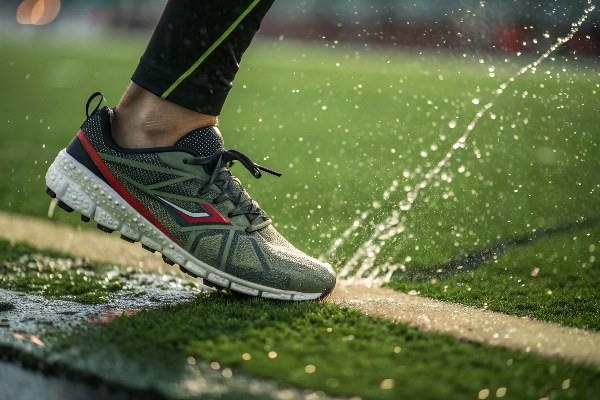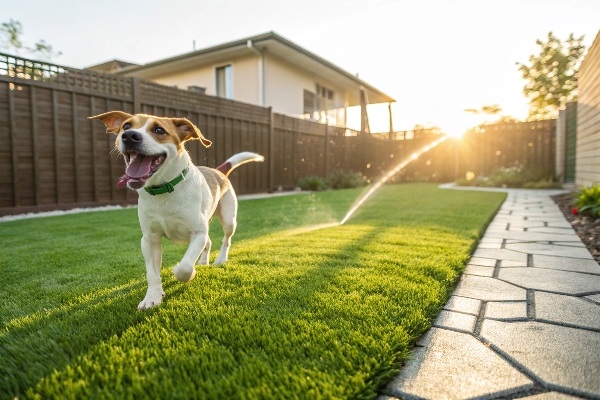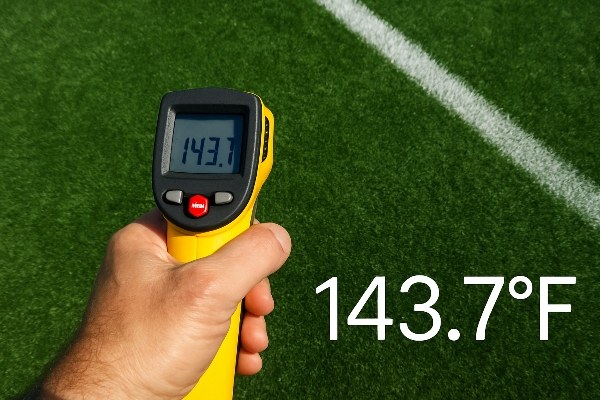Worried that your beautiful new lawn could become a dangerous slip-and-slide after a rain shower? It’s a common fear, especially for families with active kids and pets running around. You want safety, not a liability.
No, artificial grass is not excessively slippery when wet. The synthetic blades are designed to provide texture and grip, while the built-in drainage system quickly channels water away, minimizing the risk of slipping and falling.

I’ve spent years in the artificial turf industry, and this is one of the first questions customers like Mohammed from Saudi Arabia ask. They need a reliable surface for their projects, and safety is non-negotiable. It’s a valid concern, but the technology behind modern turf has come a long way. Let’s look closer at the features that keep you on your feet, even when it’s wet.
Is artificial grass anti-slip?
You’re planning a beautiful garden or a safe play area, but you’re worried about accidents. The thought of a child or a guest slipping on a damp surface can be stressful. You need a surface you can trust.
Yes, high-quality artificial grass is engineered to be anti-slip. Its design includes textured yarn and, for sports applications, infill materials like sand and rubber granules that significantly increase friction and stability, even in wet conditions.

During my time managing sales, I worked with many clients who were developing sports facilities. For them, slip resistance isn’t just a feature; it’s a critical safety requirement. A player’s performance and health depend on a stable surface. But this same technology benefits homeowners. The key is understanding how the different parts of the turf system work together to prevent slips. It’s not just about the grass blades themselves; it’s a combination of materials and design working in unison.
Here’s a breakdown of how these anti-slip features function in different settings:
| Feature | Landscaping & Leisure Use | Sports Application |
|---|---|---|
| Yarn Texture | The polyethylene blades have a texturized, non-slick surface that provides natural grip underfoot. | The yarn is often more robust and specifically shaped (like a diamond or spine shape) to maximize grip for athletic footwear. |
| Drainage System | Perforations in the backing allow water to drain through quickly, keeping the surface from becoming waterlogged and slick. | Drainage is even more critical. The entire sub-base is engineered for rapid water removal to ensure play can resume quickly after rain. |
| Infill Material | Usually not required, but a light sand infill can be added to help weigh the grass down and provide extra stability. | Essential for safety and performance. A mix of quartz sand and rubber granules provides cushioning and immense friction. |
Will dog urine ruin artificial grass?
As a dog owner, you love your pet but hate the damage they can do to a natural lawn. You’re considering turf, but you’re worried that dog urine will leave permanent stains and awful, lingering smells.
No, dog urine will not ruin modern artificial grass. The synthetic fibers are non-porous and do not absorb liquids. The urine passes through the perforated backing and drains away. Regular rinsing helps prevent any odor buildup.

I remember a client who was hesitant to install turf in his backyard because he had two large golden retrievers. He was convinced they would destroy it. I explained that unlike natural grass, which absorbs urine and develops yellow, dead patches, synthetic turf acts more like a sieve. The fibers themselves won’t stain or die. The real hero is the backing, which is designed with drainage holes to let liquids pass right through. Of course, this doesn’t mean you can ignore it completely. Proper care is simple but essential to keep everything fresh.
Here’s a deeper look at why it works and how to maintain it:
- Non-Porous Fibers: The polyethylene and polypropylene yarns used in turf are plastics. They simply cannot absorb liquid. The urine beads up and rolls off the blades, heading down to the base.
- Advanced Drainage: Every quality turf product has a backing system punched with dozens of drainage holes per square meter. This allows urine, rain, and any other liquid to flow through into the sub-base below, preventing it from pooling on the surface.
- Easy Cleaning: For basic maintenance, a simple rinse with a garden hose is often enough to wash away any residue. For more persistent odors or heavy use, a solution of water and white vinegar or a specialized enzyme cleaner can be used to neutralize any ammonia smell. I recommend a quick rinse-down once a week for homes with pets.
What are the negatives of artificial grass?
You’ve heard all the great things about artificial grass—no mowing, no watering, green all year. It sounds almost too good to be true, making you wonder what the catch is. What are the hidden downsides?
The main negatives of artificial grass are its higher initial installation cost compared to natural sod, its tendency to absorb and retain heat in direct sunlight, and environmental concerns regarding its production and end-of-life disposal.

From my engineering background, I believe in being upfront about a product’s limitations. While I’m a huge advocate for artificial turf, it’s not the perfect solution for every single situation. A customer like Mohammed needs the full picture to make an informed decision for his business. He needs to weigh the long-term benefits against the initial investment and potential drawbacks. Acknowledging these negatives is part of being a trustworthy supplier. It’s better to be honest about issues like heat absorption than to have a surprised and unhappy customer later.
Let’s break down these concerns in a more structured way:
| Concern | Deeper Explanation |
|---|---|
| Initial Cost | The upfront cost of materials and professional installation for artificial turf is significantly higher than seeding or laying sod. However, this cost is offset over time by savings on water, fertilizer, pesticides, and lawn equipment. It’s a long-term investment. |
| Heat Absorption | On hot, sunny days, synthetic turf can get much hotter than natural grass. This can be uncomfortable for bare feet or pets. Using a light-colored sand infill can help, as can a quick spray with a hose to cool the surface down. |
| Environmental Impact | The product is made from plastics and requires an industrial process. While it saves immense amounts of water and eliminates pesticides, its end-of-life recycling can be challenging, though more facilities are beginning to handle it properly. |
| "Unnatural" Feel | For some people, nothing can replace the smell and feel of real grass. While modern turf is incredibly realistic, it is still a synthetic product. It won’t have the same biological ecosystem as a natural lawn. |
Conclusion
Ultimately, artificial grass is a safe, anti-slip, and durable option that stands up well to both weather and pets. While you should consider the initial cost and heat on sunny days, its low maintenance and reliability make it a winning choice for many projects.
_画板-1.png)
_画板-1.png)